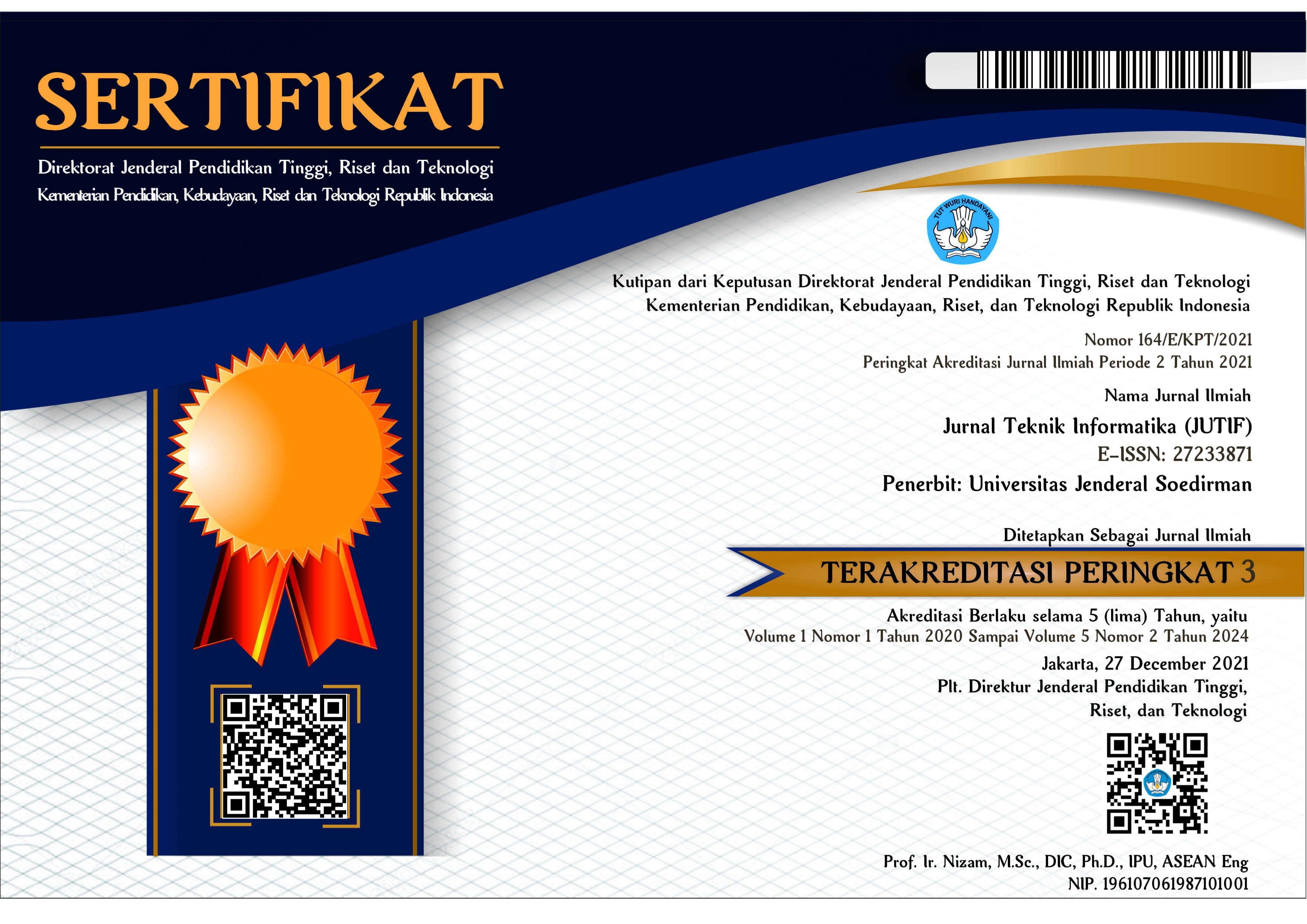ANALYSIS FEATURE EXTRACTION FOR OPTIMIZING ARRHYTHMIA CLASSIFICATION FROM ELECTROCARDIOGRAM SIGNALS
DOI:
https://doi.org/10.52436/1.jutif.2024.5.1.1267Keywords:
Arrhythmia, Dynamic Feature, Electrocardiogram, Feature ExtractionAbstract
Heart disease is the primary cause of death globally, with arrhythmias, such as Premature Atrial Contraction (PAC), Atrial Fibrillation (AF), and Premature Ventricular Contraction (PVC), being critical heart rhythm abnormalities. Although numerous studies have utilized feature extraction from electrocardiogram (ECG) signals to detect these conditions, optimal accuracy has not been achieved. Therefore, this research aims to identify relevant features and achieve better results by using dynamic feature extraction methods. The extracted features used are RR Interval, PR Interval, and QRS Complex. By combining 2 feature extractions - RR Interval & PR Interval, RR Interval & QRS Complex, and PR Interval & QRS Complex - this study achieves a high level of accuracy on the RR Interval & QRS Complex feature extraction, reaching 97.60%, with a specificity of 98.30% and sensitivity of 96.58%.
Downloads
References
A. Nigolian, N. Dayal, H. Nigolian, C. Stettler, H. Burri, Diagnostic accuracy of multi-lead ECGs obtained using a pocket-sized bipolar handheld event recorder, J. Electrocardiol. 51 (2018) 278–281.
H. Fujita, D. Cimr, Computer aided detection for fibrillations and flutters using deep convolutional neural network, Inform. Sci. 486 (2019) 231–239.
WHO 2016. https://www.who.int/cardiovascular_diseases/en/. (Accessed 28 July 2023).
M. Abdar, M. Zomorodi-Moghadam, X. Zhou, R. Gururajan, X. Tao, P.D. Barua, R. Gururajan, A new nested ensemble technique for automated diagnosis of breast cancer, Pattern Recognit. Lett. (2018).
M. Abdar, N.Y. Yen, J.C.-S. Hung, Improving the diagnosis of liver disease using multilayer perceptron neural network and boosted decision trees, J. Med. Biol. Eng. 38 (2018) 953–965.
H. Fujita, D. Cimr, Decision support system for arrhythmia prediction using convolutional neural network structure without preprocessing, Appl. Intell. (2019) 1–9.
B. M. Mathunjwa, Y.-T. Lin, C.-H. Lin, M. F. Abbod, and J.-S. Shieh, “Ecg arrhythmia classification by using a recurrence plot and convo- lutional neural network,” Biomedical Signal Processing and Control, vol. 64, p. 102262, 2021.
B. Akdemir, H. Yarmohammadi, M.C. Alraies, W.O. Adkisson, Premature ventricular contractions: Reassure or refer? Cleve. Clin. J. Med. 83 (7) (2016) 524–530.
C. Che, P. Zhang, M. Zhu, Y. Qu, and B. Jin, “Constrained transformer network for ecg signal processing and arrhythmia classification,” BMC Medical Informatics and Decision Making, vol. 21, 06 2021.
SOLIKHAH, M., NURYANI, N., AND DARMANTO, D. Deteksi aritmia pada elektrokardiogram dengan metode jaringan syaraf tiruan kelas jamak menggunakan fitur interval rr, lebar qrs, dan gradien gelombang r. Jurnal Fisika dan Aplikasinya 11 (01 2015), 36.
X. Chen, Z. Cheng, S. Wang, G. Lu, G. Xv, Q. Liu, and X. Zhu, “Atrial fibrillation detection based on multi-feature extraction and convolutional neural network for processing ecg signals,” Computer Methods and Programs in Biomedicine, vol. 202, p. 106009, 2021.
M. Karri and C. S. R. Annavarapu, “A real-time embedded system to detect qrs-complex and arrhythmia classification using lstm through hybridized features,” Expert Systems with Applications, vol. 214, p. 119221, 2023.
R. Banerjee, A. Ghose, and S. Khandelwal, “A novel recurrent neural network architecture for classification of atrial fibrillation using single- lead ecg,” in 2019 27th European Signal Processing Conference (EU- SIPCO), pp. 1–5, 2019.
H. Yang and Z. Wei, “Arrhythmia recognition and classification using combined parametric and visual pattern features of ecg morphology,” IEEE Access, vol. 8, pp. 47103–47117, 2020.
CHEN, C., HUA, Z., ZHANG, R., LIU, G., AND WEN, W. Automated arrhythmia classification based on a combination network of cnn and lstm. Biomedical Signal Processing and Control 57 (2020). Cited by : 88.
DUAN, J., WANG, Q., ZHANG, B., LIU, C., LI, C., AND WANG, L. Accurate detection of atrial fibrillation events with r-r intervals from ecg signals. PLoS ONE 17, 8 August (2022). Cited by: 0; All Open Access, Gold Open Access, Green Open Access.
Goldberger, A., Amaral, L., Glass, L., Hausdorff, J., Ivanov, P. C., Mark, R., ... & Stanley, H. E. (2000). PhysioBank, PhysioToolkit, and PhysioNet: Components of a new research resource for complex physiologic signals. Circulation [Online]. 101 (23), pp. e215–e220. M.
L. B. Marinho, N. de M.M. Nascimento, J. W. M. Souza, M. V. Gurgel, P. P. Rebouc ̧as Filho, and V. H. C. de Albuquerque, “A novel electrocardiogram feature extraction approach for cardiac arrhythmia classification,” Future Generation Computer Systems, vol. 97, pp. 564–577, 2019.




























